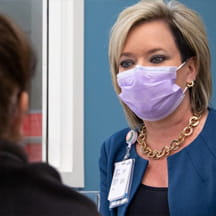It's been nearly two years since Maggie Moon, M.D., M.P.H., assumed her position as Johns Hopkins Children's Center's first-ever chief medical officer (CMO). Children's Hospitals Today caught up with Moon to discuss her approach to this new role and what's on the horizon.
It can be difficult forging the path for a new role. How has your transition to CMO been?
The role has proven to be exactly as interesting as I thought, maybe even more so. Because the children's center at Johns Hopkins is not a standalone children's hospital—we're affiliated with our larger hospital, The Johns Hopkins Hospital—the chief medical officer role is more focused on operations and managing a balance between the tripartite mission of the hospital: research, education and the highest-quality patient care.
Happily, I get to add a little extra weight to the patient care portion and, ultimately, it's my job to remind everyone to keep patient care at the forefront. It's a great job to have because Johns Hopkins Children's Center is full of people who are remarkably committed to doing the right thing and doing it well.
How do you go about striking a balance among those three competing priorities?
We recognized that one of the obstacles to achieving our mission was that we may not be communicating effectively because we all exist in such important silos. So, I started a daily group phone call.
Every morning, at exactly 9 o'clock, we have an eight-to-12-minute phone call with about 25 people engaged in every aspect of care in the children's center. Not just patient care but environmental services, pharmacy, central supply and others. It's a very targeted phone call to discuss what might be standing in the way of our providing appropriate patient care that day. It's turned out to be a beneficial call not just because we share good information, but because it enhances everyone's sense of community.
I like to joke that my only real authority in this job is the authority to ask people to convene. That's really what I do. When there's a problem or a question, I think it's very important for me to get groups of people to come together—to think outside of their own silos and share in the experience of a problem to understand it better.
Teaching is a big part of your background. How does that experience translate to this CMO role?
One of the things I love about teaching is teaching adults. I love to make it learner-centered—[to] really try and figure out what a group of learners needs from me. I think that approach to teaching makes it much easier for me to collaborate with people from all over the children's center and all over the hospital because it's that same goal of understanding, “What is this particular group all about? What do they need from me, and how can we collaborate to achieve whatever goal we're trying to achieve?”
I think teaching is a great background for anybody who's trying to lead or manage. It is so humbling and challenging, and it has really allowed me to open my mind to communicate effectively with anyone. I feel fortunate to have that background.
As you look around at the landscape of pediatric medicine today, what do you feel is the biggest challenge facing children's hospitals, and how does that shape your approach to this role?
Pediatrics really must set the tone to make everyone understand the trajectory of health. We miss the mark when we try to cure adult diseases starting at age 30. If I had a wish, it would be that we, as a country, could embrace the trajectory of health and illness starting with the prenatal period—intellectually, logically and financially.
So, I'd like to be a stronger voice for pediatrics in the health care system. As I've gained a better understanding of how our local system currently works, I'm getting more involved in strategic planning, trying to map the next 10 or 20 years of pediatrics. In that, I am certainly following the lead of our department director, Tina Cheng, who has a tremendous focus on population health and understanding of the goals for the future of pediatrics.


